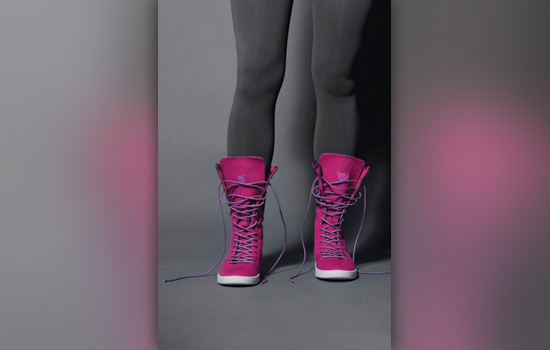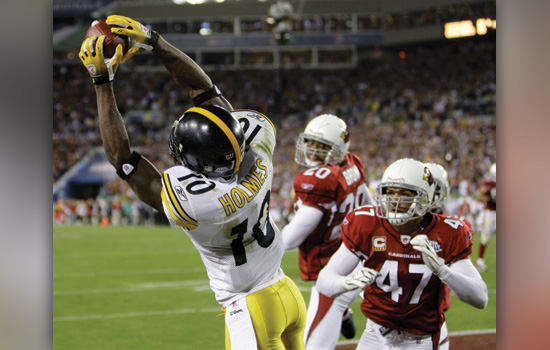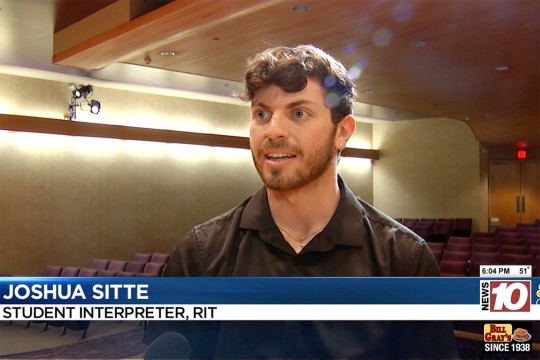By Design
Graduates are creative minds behind everyday products
Ski wear, designed by Molly Rose Urquhart ’03, for L.L. Bean.
When Pittsburgh Steelers wide receiver Santonio Holmes caught the game-winning touchdown in Super Bowl XLIII, he had a little help from RIT graduate Dan Bolinski.
Bolinski ’07 designed Holmes’ Reebok NFL Pro Lite Fade gloves, which feature a non-slip treatment on the glove’s palm to aid in gripping the ball. He also designed Reebok uniforms for the NFL, NHL, NBA and NCAA, sideline apparel worn by coaches and equipment used by trainers.
Bolinski, who worked at Reebok for three and a half years, originally enrolled as an illustration major, but during his freshman year he realized the industrial design program used many of the design skills he liked, including sculpture and drawing.
He soon learned that industrial designers are the creative minds behind the look of everyday products, from cell phones, laptops and furniture to sports cars, kitchen appliances and housewares.
Graduates work in apparel design, consumer product design, packaging, furniture design, museum exhibition design and toy design. They are employed at companies as diverse as Hasbro, Nike, K-Swiss, Tupperware, Ethan Allen, LG Electronics, Hershey Foods and Fisher-Price.
The program has grown dramatically over the past six years with a nearly 200 percent increase in applications since 2006. Last year, 184 prospective students were vying for 45 spots. Increased attention to design in the consumer products market has led to the growth.
Bolinski began his career at Reebok. During his senior year, he interned in the company’s sports licensing division. After graduation, Reebok brought him on full-time as an apparel designer. In May, Bolinski will move from Boston to Beaverton, Ore., where he will begin working for Nike, which recently signed on as the new supplier of NFL uniforms, sideline apparel and fan gear.
Most art and design students come to RIT with little knowledge of the industrial design field. The program often sees students transfer from other art disciplines, as well as from majors as diverse as engineering and packaging science.
Molly Rose Urquhart ’03 came to RIT as a graphic design major but soon transferred after having an experience similar to Bolinski’s.
“I started making friends in the college and started seeing students’ work in 3D and I thought it was so much more hands-on and tangible versus graphic design,” says Urquhart, who designs men’s and women’s active outerwear and women’s active apparel at L.L. Bean. Her office is located a few blocks away from the company’s flagship store in Freeport, Maine.
Urquhart has worked for L.L. Bean since 2003. She was hired after completing an internship with the clothing and footwear company.
“One thing I really love about my job is that you truly get to see the end result,” she says. “The idea for a project comes out of your head, onto a piece of paper and one day I can be at a ski resort and see someone wearing my jacket. It’s the coolest feeling on earth.”
Sam Aquillano ’04 shares Urquhart’s high regard for the applied nature of their career field.
“The great thing about RIT is its very practical approach to design. We had studio courses in furniture design, housewares, and medical equipment. Designing projects in these different sectors, I felt very prepared coming out of school,” he says.
Aquillano is a designer at Bose Corporation in Boston, where he designs components for high-performance audio systems. He reduced his full-time schedule to two days a week to focus on teaching at both Wentworth Institute of Technology and the Massachusetts College of Art and Design, and to help establish Design Museum Boston, an idea that grew out of Aquillano’s passion for sharing design with the world.
Aquillano landed an internship at Bose after attending a portfolio review at an Industrial Design Society of America conference. After graduating, Bose offered him a job.
“I think the main thing that got me the job at Bose was that my work was very practical and it was able to be made,” he says. “It was real, not just a fake design project.”
 Tasha Super Hi Shoe, designed by Luz Zambrano ’04, for Gravis Footware/Burton Snowboards.
Tasha Super Hi Shoe, designed by Luz Zambrano ’04, for Gravis Footware/Burton Snowboards.
 Dan Bolinski ’07 designed the gloves worn by Pittsburgh Steelers wide receiver Santonio Holmes (10), who catches a touchdown pass as Arizona Cardinals Ralph Brown watches during the fourth quarter of the NFL Super Bowl XLIII on Feb. 1, 2009, in Tampa, Fla.
Chris O’Meara
Dan Bolinski ’07 designed the gloves worn by Pittsburgh Steelers wide receiver Santonio Holmes (10), who catches a touchdown pass as Arizona Cardinals Ralph Brown watches during the fourth quarter of the NFL Super Bowl XLIII on Feb. 1, 2009, in Tampa, Fla.
Chris O’Meara















